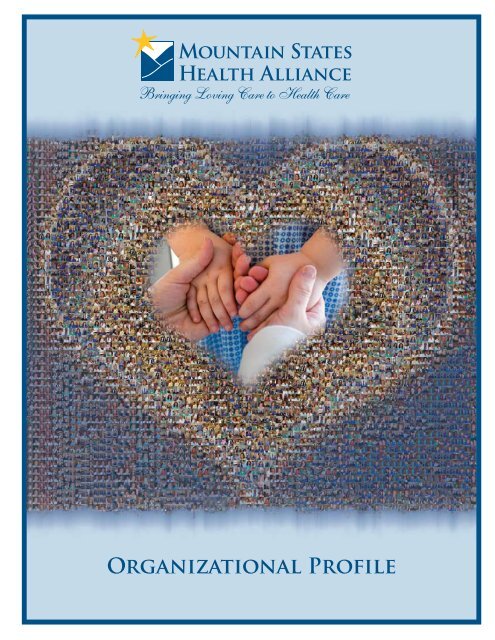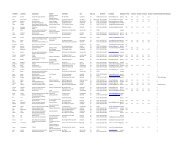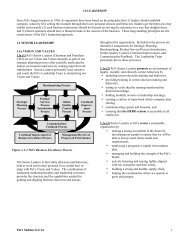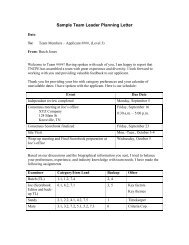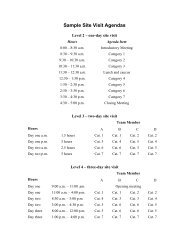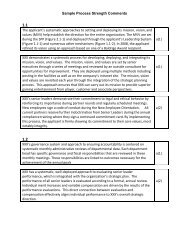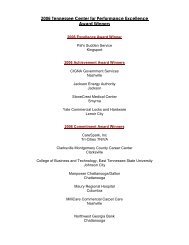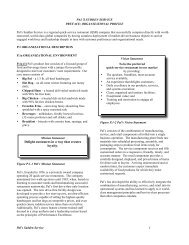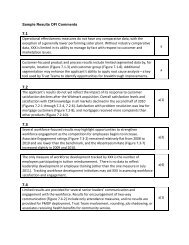Preface: Organization Profile - Tennessee Center for Performance ...
Preface: Organization Profile - Tennessee Center for Performance ...
Preface: Organization Profile - Tennessee Center for Performance ...
Create successful ePaper yourself
Turn your PDF publications into a flip-book with our unique Google optimized e-Paper software.
Mountain States<br />
Health Alliance<br />
<strong>Organization</strong>al <strong>Profile</strong>
P.1. ORGANIZATIONAL DESCRIPTION<br />
Mountain States Health Alliance (MSHA) is a large, well<br />
planned, not-<strong>for</strong>-profit health care system. The system<br />
provides a core of acute care, hospital-based services, and an<br />
array of supporting services to a population of over 1 million<br />
residents of southern and central Appalachia. Services are<br />
delivered through a “hub and spoke” geographic/service area<br />
represented by the MSHA Star in Figure P.1-1. The hub is<br />
Johnson City Medical <strong>Center</strong> (JCMC), a tertiary care<br />
hospital located in East <strong>Tennessee</strong> with spokes reaching out<br />
to Middle <strong>Tennessee</strong>, Eastern Kentucky, Western North<br />
Carolina, and Virginia. Services are supported by<br />
ambulatory care options such as outpatient surgery,<br />
laboratory and radiology; home health; physician practices;<br />
long-term care and rehabilitation; and community based<br />
prevention and educational activities. Mountain States<br />
Healthcare Network (MSHN), an affiliated network of 53<br />
regional hospitals and nursing homes spanning Virginia,<br />
Kentucky, and North Carolina provides a referral network<br />
and continuum of care <strong>for</strong> regional residents and is an<br />
integral part of the hub and spoke geographic/service area.<br />
P.1a <strong>Organization</strong>al Description<br />
P.1a1 Main Health Care Service Offerings MSHA’s main<br />
healthcare service is acute care. Acute care services,<br />
identified based on an analysis of regional healthcare needs,<br />
are segmented into five service lines or strategic service<br />
units (SSUs): cardiovascular, oncology, ortho-neuro,<br />
behavioral health, and women’s services. Additional service<br />
lines include children’s services, general medicine, surgery,<br />
emergency and trauma care, intensive care, laboratory,<br />
pharmacy, and radiology. Acute care services are delivered<br />
primarily in hospital settings. Specialty care services in each<br />
MSHA facility are tailored to community needs and to the<br />
unique resources and strengths of the particular hospital<br />
(OC-5).<br />
An array of other healthcare services supports MSHA’s<br />
main hospital service offerings. These services are delivered<br />
in a variety of settings including clinics and community<br />
health centers; primary care and specialty practices, and<br />
patient homes. Health advice, scheduling and referrals are<br />
<strong>Organization</strong>al <strong>Profile</strong><br />
delivered by phone and via MSHA's web site.<br />
P.1a2 <strong>Organization</strong>al Culture “The MSHA Difference”<br />
reflects the key characteristics of MSHA’s culture (Figure<br />
P.1-2). The Mission, Vision, and Values (MVV) <strong>for</strong>m the<br />
foundation of the House of Quality from which MSHA<br />
manages its business, and serve as the basis <strong>for</strong> decisionmaking<br />
at all levels. Four Pillars of Excellence – Clinical<br />
Effectiveness, Operational Effectiveness, Stakeholder<br />
Safety, and Service Excellence – rise from the foundation<br />
and support the organization’s strategy and commitment to<br />
excellence. The MSHA work<strong>for</strong>ce (WF) is responsible <strong>for</strong><br />
“bringing loving care to health care” by living out the<br />
Patient-<strong>Center</strong>ed Care (PCC) guiding principles which drive<br />
behavioral expectations and standards and are rooted in the<br />
Appalachian tradition of caring <strong>for</strong> family and friends.<br />
MSHA’s core competency is “bringing loving care to<br />
health care” through The MSHA Difference. This focus on<br />
the House of Quality, the MVV, PCC guiding principles,<br />
and the WF enables MSHA to deliver superior, patient<br />
centered service to the people of the region.<br />
P.1a3 Work<strong>for</strong>ce <strong>Profile</strong> The WF includes team members<br />
(TMs), physicians, volunteers, and students. MSHA has<br />
7,813 TMs. There are 1,220 physicians and allied health<br />
providers with privileges, all of whom are credentialed<br />
according to policy by the MSHA Board of Directors. There<br />
are currently 2,826 dedicated volunteers and nearly 1,000<br />
students each academic semester. There is also a pool of<br />
temporary employees, all of whom are required to attend<br />
orientation and are available on renewable 13-week<br />
contracts as needed. WF segments and key engagement<br />
factors are described in Figure P.1-3 and the TM<br />
demographics are listed in Figure P.1-4.<br />
Key WF health and safety requirements, including<br />
ergonomics, infection prevention and control, hazardous<br />
materials and radiation management, and fire and emergency<br />
preparedness are addressed through systematic safety<br />
practices.<br />
Key benefits are provided in a flexible package to meet<br />
individual needs and preferences. Employed TM and<br />
physician benefits include health, dental, vision and longterm<br />
care insurance, critical care, cancer, flexible spending<br />
Hub and Spoke Geographic/Service Area<br />
Figure P.1-1 Hub and Spoke Geographic/Service Area<br />
Mountain States Health Alliance<br />
i
<strong>Organization</strong>al <strong>Profile</strong><br />
accounts, pet insurance and retirement plans. Two daycare<br />
facilities are available at discounted rates, and two large,<br />
well-equipped Wellness <strong>Center</strong>s are provided at low cost to<br />
the entire WF.<br />
P.1a4 Facilities, Technologies and Equipment Facilities<br />
include 14 hospitals, 4 Urgent Care <strong>Center</strong>s, 4 Value Care<br />
Clinics, 10 Homecare and Hospice <strong>Center</strong>s, 4 RehabPlus<br />
Locations, the Blue Ridge Physician Group, the Blue Ridge<br />
Medical Management Corporation, 3 Mediserve Medical<br />
Equipment entities, and 2 Wellness <strong>Center</strong>s. PCC principles<br />
are integrated into facilities throughout the system, and<br />
influence room arrangements, colors, and features such as<br />
fountains and gardens in an ef<strong>for</strong>t to create a peaceful,<br />
healing environment.<br />
MSHA uses advanced in<strong>for</strong>mation system technologies to<br />
maximize efficiency, effectiveness and safety in clinical<br />
care. Project: SAFETYfirst is a comprehensive multi-year<br />
project to improve and integrate clinical systems. MSHA<br />
partners with other health systems and services in the region<br />
such as CareSpark, a nationally recognized Regional Health<br />
In<strong>for</strong>mation <strong>Organization</strong> that will enable sharing of portions<br />
of medical records among the partners. A variety of other<br />
in<strong>for</strong>mation systems support administrative and business<br />
operations. E-mail and the intranet and Internet sites<br />
facilitate communication within MSHA, and with patients<br />
and area residents.<br />
Delivery of high-quality health care services requires the<br />
latest specialized equipment. The JCMC ICU incorporates<br />
• All team members are considered as caregivers<br />
• Care is based on continuous healing<br />
• Care is customized and reflects patient needs, values and<br />
choices<br />
• Families and friends of the patient are considered an essential<br />
part of the care team<br />
• Care is provided in a healing environment <strong>for</strong> com<strong>for</strong>t, peace and<br />
support<br />
The MSHA Difference “Bringing Loving Care to Health Care”<br />
Patient-<strong>Center</strong>ed Care Guiding Principles<br />
state-of-the-art equipment, including mobile gas and<br />
equipment columns that allow 360° access to patients and<br />
monitors. To provide the best cancer diagnosis and<br />
treatments, MSHA uses IMRT and stereotactic radio surgery<br />
and breast biopsy, HDR/LDR brachytherapy and PET/CT.<br />
High field open MRI provides excellent quality and more<br />
com<strong>for</strong>table experiences <strong>for</strong> patients. Flow cytometry and an<br />
anatomic pathology reporting system have improved<br />
laboratory services while extensive pharmacy automation<br />
speeds medication dispensing and delivery to patients.<br />
P.1a5 Legal and Regulatory Environment MSHA<br />
complies with appropriate health, safety, accreditation,<br />
certification, in<strong>for</strong>mation protection, financial, human<br />
resource, and patient care laws and regulations. Aspects of<br />
the legal and regulatory environment are found in Figure<br />
P.1- 5.<br />
P.1b <strong>Organization</strong>al Relationships<br />
P.1b1 <strong>Organization</strong>al Structure and Governance System<br />
MSHA’s organizational structure and governance system<br />
combines a centralized strategic orientation with<br />
decentralized operational responsibilities. This system<br />
consists of a System Board of Directors (MSHA Board),<br />
Community Boards, subsidiary boards, Medical Executive<br />
Committees (MECs), and the Executive Leadership Team<br />
(ET). This governance structure assures attention to key<br />
factors that impact the systemness of MSHA, while<br />
integrating the perspectives of each facility and its<br />
• Knowledge and in<strong>for</strong>mation are freely shared between and<br />
among the patients, care partners, physicians and other care<br />
givers<br />
• Transparency is the rule in the care of the patient<br />
• Patient safety is a visible priority<br />
• All caregivers cooperate with one another through a common<br />
focus on the best interests and personal goals of the patient<br />
• The patient is the source of control <strong>for</strong> their care<br />
Team Members- MSHA has 7,813<br />
employed team members.<br />
Physicians- MSHA has 1,220<br />
physicians and allied health<br />
professionals.<br />
Volunteers- MSHA has 2,826<br />
volunteers.<br />
Students- MSHA can have over 1,000<br />
students at any time.<br />
Mission - Mountain States Health Alliance is committed to “Bringing Loving Care to Health<br />
Care”. We exist to identify and respond to the health care needs of individuals and<br />
communities in our region and to assist them in attaining their highest possible level of health.<br />
Vision - We passionately pursue the healing of the mind, body, and spirit as we create a<br />
world-class healthcare system.<br />
Figure P.1-2 The MSHA Difference “Bringing Loving Care to Health Care”<br />
Values:<br />
Integrity… honesty in everything we do<br />
Service… with caring and compassion<br />
Leadership… with creativity and innovation<br />
Excellence… always pursuing a higher<br />
standard<br />
ii<br />
Mountain States Health Alliance
<strong>Organization</strong>al <strong>Profile</strong><br />
Segment<br />
TMs<br />
Physicians<br />
Volunteers<br />
Students<br />
community’s needs.<br />
Key WF Engagement Factors<br />
Engagement Factors<br />
Recognition, cooperation in the work unit, respect<br />
Ability to provide quality patient care, access to<br />
state-of-the-art equipment, appropriate facilities<br />
Recognition<br />
Access to applicable experiences<br />
Figure P.1-3 Key WF Engagement Factors<br />
Boards: The 13-member System Board of Directors provides<br />
overall governance and strategic oversight. Except <strong>for</strong> the<br />
President/Chief Executive Officer (CEO), who sits on the<br />
System Board, all board members are independent<br />
volunteers. Community Boards set long range plans <strong>for</strong> the<br />
hospitals within their counties, and work closely with leaders<br />
in each hospital, who have day-to-day management<br />
responsibility. Additional subsidiary boards, such as<br />
BRMMC, MS Foundation, and MSHA Auxiliary, oversee<br />
aspects of the corporation that require separate governance<br />
structures. The System Board approves all decisions of the<br />
Community Boards and subsidiary boards.<br />
MECs: MECs are responsible <strong>for</strong> the credentialing of<br />
physicians, nurse practitioners, and physician assistants <strong>for</strong><br />
practice privileges. These are county-based committees<br />
Type of<br />
Position<br />
Status<br />
Gender<br />
MSHA TM Demographics<br />
Factor <strong>Profile</strong> # / % of total staff – 7,813<br />
Race / Ethnicity<br />
Tenure<br />
Median Age<br />
Clinical 5202 / 66.6%<br />
Non-clinical 1973 / 25.3%<br />
Management 638 / 8.1%<br />
Full Time 5897 / 75.5%<br />
Part-time 1916 / 24.5%<br />
Male 1558 / 19.9%<br />
Female 6255 / 80.1%<br />
White 7552 / 96.7%<br />
African-American 112 / 1.4%<br />
Hispanic 43 / 0.6%<br />
Other 106 / 1.3%<br />
Clinical<br />
<strong>Profile</strong><br />
Non-clinical<br />
Management<br />
Clinical<br />
Non-clinical<br />
Management<br />
Figure P.1-4 MSHA TM Demographics<br />
# Years<br />
6 yrs.<br />
7.53 yrs.<br />
11.52 yrs.<br />
39.2 yrs.<br />
44.4 yrs.<br />
46.9 yrs.<br />
Body<br />
U.S. Office of Civil Rights<br />
(HIPPA)<br />
IRS<br />
State of TN/<br />
Commonwealth of VA<br />
<strong>Center</strong>s <strong>for</strong> Medicare and<br />
Medicaid Services (CMS)<br />
Office of Inspector General<br />
EPA<br />
OSHA/TOSHA<br />
EEOC<br />
Nuclear Regulatory<br />
Commission<br />
FDA<br />
Joint Commission<br />
CAP<br />
CARF<br />
CAVL<br />
ACSC on Cancer<br />
CHAPS<br />
AASM<br />
AACPR<br />
ACR<br />
American Osteopathic<br />
Association (AOA)<br />
Legal and Regulatory Environment<br />
Area<br />
Privacy and security of data<br />
Not-<strong>for</strong>-profit status<br />
Licensure/certification<br />
Conditions of<br />
participation/reimbursement rules<br />
Physician compensation (Stark antikickback)<br />
Environmental protection<br />
Team member safety<br />
Equal opportunity employment<br />
Use of radioactive isotopes<br />
Pharmacy/mammography<br />
Accreditation/Certification<br />
All hospitals<br />
Long term care, Lab, Home Health<br />
(SCCH)<br />
Primary Stroke (JCMC)<br />
Clinical laboratories<br />
Rehabilitation (Quillen, NCH)<br />
Vascular laboratories<br />
Oncology<br />
Home Health (except SCCH)<br />
Sleep laboratories<br />
Cardiac rehabilitation<br />
Radiology/mammography<br />
Healthcare Facilities Accreditation<br />
Program (HFAP) (NCH, DCH)<br />
Figure P.1-5 Legal and Regulatory Environment<br />
made up of physicians elected by members of the medical<br />
staff and are led by an elected chair. This process was<br />
established within the governance structure. Provider review<br />
and recommendation take place through the MEC to each<br />
county board. Final approval of privileges occurs at the<br />
System Board.<br />
Executive Team: Executive leaders responsible <strong>for</strong> hospitals,<br />
SSUs, and system support services, join Chief Medical<br />
Officers and the CEO to <strong>for</strong>m this component of MSHA’s<br />
governance structure. This group is responsible <strong>for</strong> both<br />
strategic and operational plans and results.<br />
P.1b2 Key Market Segments, Patient and Stakeholder<br />
Groups MSHA identified its five SSUs as its key healthcare<br />
market segments. Its key stakeholders in these segments are<br />
patients and their families (referred to collectively as<br />
Mountain States Health Alliance<br />
iii
<strong>Organization</strong>al <strong>Profile</strong><br />
“patients”) as well as the local community. MSHA<br />
recognizes that patients can be further segmented based on<br />
service setting to include inpatients, outpatients, emergency,<br />
ambulatory, home health, and urgent care and physician<br />
offices; however all segments have identified the same<br />
requirements in relationship to their continuum of care.<br />
Stakeholders and their key requirements are shown in Figure<br />
P.1-6.<br />
P.1b3 Key Suppliers, Partners and Collaborators Key<br />
types of suppliers are those who provide surgical supplies,<br />
medical devices and implants, diagnostic equipment and<br />
supplies, pharmaceuticals and pharmacy automation, dietary<br />
services, patient in<strong>for</strong>mation systems, hospital furniture, and<br />
environmental services. Suppliers play a key role in MSHA's<br />
delivery of healthcare services by helping address needs<br />
such as current technology, specialized services, and<br />
effective cost management. Equipment suppliers often play a<br />
role in our work systems by providing on-site support <strong>for</strong><br />
equipment installation, and TM and physician training. A<br />
few suppliers deliver services on-site (e.g., dietary and<br />
environmental services) and are integral to service delivery<br />
processes.<br />
Key partners include Morrison Food Services <strong>for</strong> the<br />
provision of food & nutrition services in eight MSHA<br />
facilities. This partnership has resulted in innovations in<br />
meal delivery methods. Innovation in facility cleanliness<br />
was achieved through a partnership with HHS, a relationship<br />
that has resulted in the delivery of a cleaner setting, and in<br />
an increased patient perception of cleanliness.<br />
In addition to these partnering relationships, MSHA is<br />
part owner in Premier, a national group purchasing<br />
organization and previous Baldrige recipient with nearly<br />
1,500 participating hospitals. By aggregating the purchasing<br />
power of its participants, Premier negotiates purchasing<br />
contracts on behalf of participants <strong>for</strong> competitively priced,<br />
high-quality products, thereby playing a key role in MSHA’s<br />
healthcare delivery processes and support services.<br />
Through the hub and spoke geographic/service area,<br />
MSHN affiliates collaborate with MSHA to ensure that a full<br />
range of healthcare services are available and provide<br />
referrals to the system. Collaborations with research<br />
hospitals (e.g., Johns Hopkins, St. Jude's), universities (e.g.,<br />
East <strong>Tennessee</strong> State University), and participation in<br />
national improvement projects and collaboratives (e.g.<br />
QUEST) help MSHA identify innovative protocols and<br />
Stakeholder<br />
Patients<br />
Community<br />
Key Stakeholder Requirements<br />
Key Requirements<br />
Attentiveness, In<strong>for</strong>mation/Involvement in<br />
Decisions, Friendliness/Courtesy, Prompt<br />
Service, Coordination of Care, Skill/Competence<br />
of Caregivers, Pleasant Environment, Good<br />
Meals<br />
Availability of services, health-related education,<br />
support <strong>for</strong> community activities and<br />
development<br />
Figure P.1-6 Key Stakeholder Requirements<br />
Key Competitors and Collaborators<br />
Entity Competitor Collaborator<br />
MSHN Affiliates <br />
Wellmont Health System <br />
Privately owned surgical and<br />
diagnostic centers<br />
Home health/Hospice agencies <br />
ETSU College of Medicine<br />
Blue Cross-Blue Shield<br />
BRMMC <br />
Figure P.1-7 Key Competitors and Collaborators<br />
practices to improve health care in the region and<br />
nationwide. MSHA works closely with ETSU and other<br />
colleges and universities that train nurses, physicians, and<br />
allied health professionals to build the capacity and quality<br />
of the regional healthcare work<strong>for</strong>ce.<br />
Key mechanisms <strong>for</strong> communication with suppliers,<br />
partners, and collaborators occur daily, weekly or monthly<br />
as the relationship requires through the use of e-mail, phone,<br />
the Internet, and face-to-face during site visits. These<br />
relationships are managed via <strong>for</strong>mal vendor agreements and<br />
contracts. The key supply chain requirement is Fill Rates.<br />
P.2. ORGANIZATIONAL SITUATION<br />
P.2a Competitive Environment<br />
P.2a1 Competitive Position Created in 1998 with the<br />
acquisition of six area hospitals, MSHA is the largest<br />
healthcare system in the region. It surpasses its primary<br />
competitor in number of hospitals (14 vs. 8) and bed size<br />
(1,706 vs. 1,276). The total service area comprises a 29-<br />
county, predominantly rural market with a stable aging<br />
population base and a projected growth rate through 2013 of<br />
1.5%. Nearly 98% of MSHA inpatient cases come from this<br />
market – 78.9% from the eight counties in which MSHA<br />
hospitals are located and 19.0% from the counties<br />
immediately adjacent to them. MSHA continues to increase<br />
overall service volumes; and the five SSUs each lead in their<br />
individual market segments across the region. A list of key<br />
competitors and collaborators is found in Figure P.1-7.<br />
P.2a2 Principle Factors Determining Success Factors that<br />
determine MSHA’s success relative to other healthcare<br />
organizations include a focus on The MSHA Difference; a<br />
well developed and fully deployed SPP; a commitment to<br />
continuous improvement; and a unique ability to take full<br />
advantage of the hub and spoke geographic/service area.<br />
The MVV drive ET decision-making, and serve as the<br />
foundation <strong>for</strong> the SPP. Board members, the ET and the WF<br />
understand and internalize the MVV which are shared by the<br />
President/CEO during orientation. The MSHA Difference<br />
attracts patients, TMs, physicians, volunteers, and students,<br />
and the mission of “bringing loving care to health care” is<br />
recognized and associated with MSHA by 71% of the<br />
region’s population. The Pillar-based strategic planning<br />
process focuses the organization on activities that are<br />
<br />
<br />
<br />
<br />
iv<br />
Mountain States Health Alliance
mission-driven and important to success. MSHA’s<br />
commitment to continually improving quality is seen in the<br />
adoption of the Baldrige National Quality Program Health<br />
Care Criteria <strong>for</strong> Per<strong>for</strong>mance Excellence as the business<br />
model, and in the extensive support <strong>for</strong> quality improvement<br />
through Blueprints and PI processes. This commitment has<br />
led to gains against national benchmarks and the<br />
achievement of state and national recognition <strong>for</strong> the system<br />
(7.6a1). Through its focus on "systemness," MSHA creates<br />
standardized, system-wide processes that provide<br />
consistency and promote efficiency, while allowing facility<br />
leaders the freedom and authority needed to promote<br />
innovation and agility.<br />
Key changes taking place that affect MSHA’s<br />
competitive situation include the systematic development of<br />
the hub and spoke geographic/service area through the<br />
purchase of hospitals in core service areas, and the building<br />
of the new Niswonger Children’s Hospital. Changes<br />
affecting opportunities <strong>for</strong> innovation are the design and<br />
construction of new facilities (ex. Franklin Woods<br />
Community Hospital); this facility is being built to meet<br />
LEED standards and will serve as MSHA’s first “green”<br />
hospital. Changes that create opportunities <strong>for</strong> collaboration<br />
include a recent change in CEO leadership at competitor<br />
WHS. As a result, a landmark collaborative approach to<br />
Quality is being designed by two teams made up of leaders<br />
from MSHA and WHS. The MSHA/WHS Quality team has<br />
jointly produced public service messages in the community<br />
urging individuals to get flu vaccines.<br />
P.2a3 Key Available Sources of Comparative and<br />
Competitive Data Key available sources of comparative<br />
and competitive data from within the healthcare industry and<br />
external to healthcare include: Premier, Inc, Thomson, Fitch,<br />
Standard & Poor’s, NDNQI, National Consumer Research,<br />
Press-Ganey, and Morehead Associates.<br />
Limitations to obtaining comparative and competitive<br />
data are: a lack of consistency in definitions and<br />
calculations among healthcare systems; time lags of up to<br />
a year between data collection and posting of publicly<br />
available healthcare comparisons; the strict<br />
confidentiality of most healthcare related data.<br />
P.2b Strategic Context Strategic challenges have an<br />
influence on MSHA’s ability to maintain high standards of<br />
excellence as defined by the four Pillars of Excellence<br />
(Figure P.1-2) and are addressed in the annual SPP. Primary<br />
challenges are nursing shortages and changes in<br />
reimbursement and debt.<br />
MSHA benefits from many strategic advantages.<br />
Experienced, results-oriented leadership, effective<br />
governance, a commitment to The MSHA Difference, a<br />
focus on “systemness”, and a proactive systematic SPP<br />
create a sense of purpose. The skill and work ethic of<br />
MSHA’s WF, its size, wide range of services, and the hub<br />
and spoke geographic/service area make it a leader in<br />
providing healthcare services in the region it serves.<br />
Relationships – with MSHN affiliates, and other external<br />
<strong>Organization</strong>al <strong>Profile</strong><br />
organizations – keep MSHA abreast of regional needs and<br />
emerging national trends in health care.<br />
Key challenges associated with organizational<br />
sustainability include resource shortages in the areas of<br />
nursing, other human resources, and finance. Key<br />
advantages linked to sustainability are the hub and spoke<br />
geographic/service area and The MSHA Difference.<br />
P.2c Per<strong>for</strong>mance Improvement System In 2002 MSHA<br />
adopted the Baldrige National Quality Program Health Care<br />
Criteria <strong>for</strong> Per<strong>for</strong>mance Excellence as its business model, or<br />
framework <strong>for</strong> organizational improvement. Participation in<br />
both the Baldrige and TNCPE application processes serve as<br />
the approach. By involving multiple levels of the<br />
organization in application development and resolution of<br />
opportunities <strong>for</strong> improvement, the criteria are deployed<br />
through the organization. MSHA evaluates its progress and<br />
learns from it by using the feedback report as input to<br />
strategic planning and systems improvement ef<strong>for</strong>ts, and has<br />
successfully integrated this organization level improvement<br />
approach by encouraging TMs to serve as national and state<br />
examiners. Over 50 TMs have served as examiners at either<br />
the state or national level.<br />
The MSHA Blueprint Process provides the means <strong>for</strong><br />
systematically evaluating the effectiveness of key processes.<br />
Beginning at the system level and cascading down to the<br />
level of each individual TM, leaders create annual<br />
per<strong>for</strong>mance plans called Blueprints. The Blueprint Process<br />
focuses per<strong>for</strong>mance improvement in areas of strategic<br />
importance. It also drives data selection, collection,<br />
aggregation, and analysis, facilitating management by fact,<br />
and per<strong>for</strong>mance measurement.<br />
MSHA’s approach to continual process improvement is<br />
Plan-Do-Check-Act. MSHA improves through the use of<br />
this systematic process and through the use of industry<br />
standard quality tools such as root cause analysis, evidencebased<br />
research, and best practice sharing. Whenever<br />
per<strong>for</strong>mance monitoring and review indicate that a process is<br />
not meeting customer or operational requirements, or when a<br />
benchmark has changed and a higher level of per<strong>for</strong>mance is<br />
required, leaders and TMs use PDCA to develop<br />
improvements. Collaborative Teams, PI Project Teams, and<br />
Individual PI Projects are MSHA’s identified mechanisms to<br />
accomplish system, team or individual improvements. In<br />
2006, MSHA’s approach to process improvement was<br />
enhanced with the addition of the collaborative approach<br />
developed by the Institute <strong>for</strong> Healthcare Improvement<br />
(IHI), which includes small tests of change. Further<br />
enhancements have been made by adding TMs with<br />
extensive Lean experience as Improvement Advisors in the<br />
PI Department.<br />
Mountain States Health Alliance<br />
v


